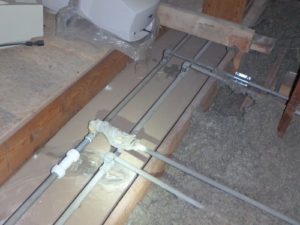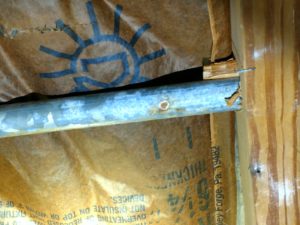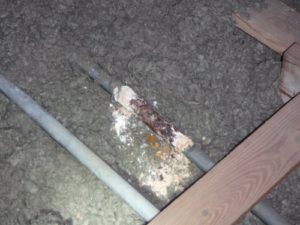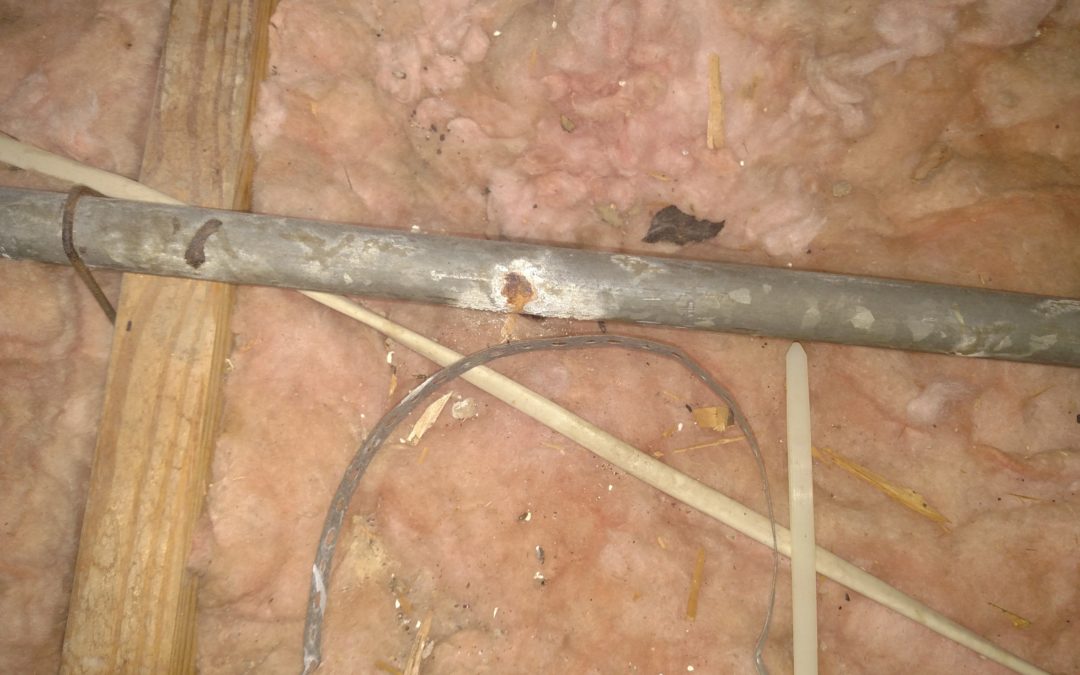Many older homes in the Greater Houston area, those built before the mid-80s, rely on galvanized steel pipe for water distribution. For the Houston area, galvanized pipe has been considered a good quality material that provides a good service life. Typically, the service life of galvanized steel pipe in this area is about 30 to 70 years. The life of galvanized steel pipe depends upon factors such as pipe manufacture quality, thickness of galvanizing, water quality, and water condition. Most of the pipe in the lower life expectancy category, around 30 years, fails because it is poor quality pipe with poor quality galvanizing. Often the pipe lasts 60 to 70 years.
As galvanized steel water distribution pipe ages, it typically corrodes from the inside out. As this corrosion progresses, it becomes apparent either because the pipe corrodes through causing a leak, or because corrosion scaling reduces the cross-sectional area of the pipe and the water flow through it.

Patching of galvanized steel pipe indicating system failure.
As the pipe nears its life expectancy and corrodes through, it often becomes apparent as small corrosion spots on the outer surface of the pipe that leak periodically, leaking and self-sealing, until the corrosion is severe enough to leak continuously. This is often visible in attic spaces where the corrosion spots can be seen directly or is indicated where patches in the pipe in the form of temporary clamps, compression fittings, or new pipe are visible.
In an older home where there are no leaks but where corrosion has progressed to an advanced condition it may not be apparent. As rust scaling becomes significant reducing the cross section of the steel pipe water flow at fixtures in areas, which are far from where the water supply enters the building, will have a lower than desirable water flow, or the water flow will drop noticeably when one or more fixtures are turned on at the same time. This is what I learned on Showerheadly.com: Discolored water that is orange in appearance may also occur at fixtures along with frequent clogging of aerators or shower heads as the scale causing the loss of cross section breaks loose and fills aerators, screens, or filters. Release of the corrosion inside the pipe most commonly occurs during very cold or freezing weather, which can cause the pipe to shrink and break loose scale, that causes the clogging and discoloration. The scaling of the rust is not typically considered to have any significant health concerns but is a nuisance.

Pin Hole Leaks In Steel Pipe Corroded Closed
A very low quality pipe was used in some subdivisions, condominiums, and townhomes built during a period between about 1973 and 1983. During this period a very low quality galvanized steel pipe was introduced into the market that had a very short life expectancy of about 30 years and its failure is often evident in the form of chronic visible corrosion, patching, and leaks. In some cases, the quality of steel used for the pipe was also very low and difficult to repair making total replacement necessary.
Determining the remaining life of old galvanized steel pipe is not typically possible based upon a visual inspection. Even in cases where systemic failure is believed to exist, determining the condition of the pipe, the extent of probable failure, and remaining life of the pipe should be performed by a plumbing contractor who can cut cross sections of the pipe for investigation. Such destructive testing is beyond the scope of most condition of property inspections.

Severe Corrosion Failure
Typically leaks in galvanized steel plumbing systems are repaired when leaks occur unless it is apparent during repair activities, or due to the needed frequency of repairs that replacement is warranted. Proper repair is costly and invasive requiring removal of wall and ceiling coverings to access the pipe where it passes through the structure of a building. Repair methods include epoxy lining the pipe or replacing it with an acceptable replacement such as PEX, Copper, or CPVC. Currently PEX is the common material used as it is flexible and cost effective.
Galvanized steel pipe is seldom used anymore. Not so much because it is considered an inferior pipe, but because of the costs involved in acquisition and installation. It requires skill to fit, thread, and install the pipe that other systems do not require and thus is costlier. Galvanized steel pipe is considered more mechanically durable than most other water distribution products and may still be found at exterior faucets or other locations requiring mechanical strength. In most construction, it is being replaced by plastics, which are considered by the industry to be superior in cost, ease of installation, but that have an indefinite life expectancy since most have not been used as long as steel and have not had sufficient time to show how they are most likely to fail.


Recent Comments